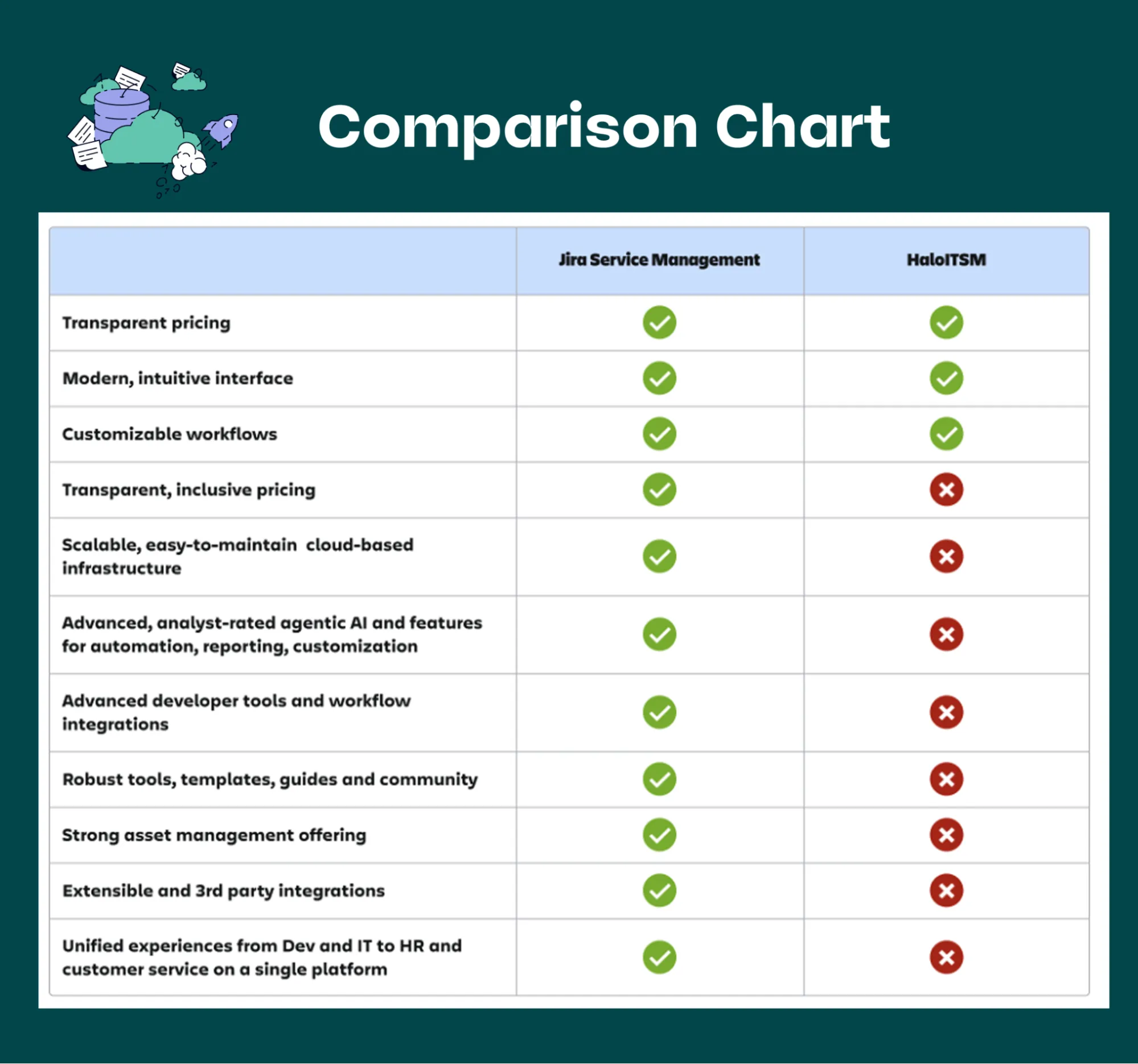When organizations set out to modernize their IT Service Management (ITSM) approach, two platforms often rise to the top of consideration: HaloITSM and Jira Service Management (JSM).
This guide compares HaloITSM and JSM across cost, functionality, and business fit—helping you determine which platform best aligns with your organization’s growth and IT strategy.
HaloITSM vs. JSM

HaloITSM is an IT service management (ITSM) platform designed to help IT teams streamline support, manage requests, and improve service delivery. It focuses on simplicity, offering a modern and intuitive user interface, quick deployment, and out-of-the-box ITIL-aligned functionality. HaloITSM is particularly well-suited for organizations in the early to mid stages of ITSM maturity that need a straightforward, user-friendly solution without extensive customization or complexity.
Jira Service Management (JSM) is Atlassian’s ITSM solution built on the Jira platform. It provides powerful service management capabilities that integrate seamlessly with DevOps, IT, and business teams. JSM is designed for scalability and advanced functionality, offering automation, AI-driven service management, incident and change management, and deep integration with Atlassian tools, such as Jira Software and Confluence. It is ideal for growing or enterprise organizations that need a future-proof platform capable of supporting complex IT operations and cross-team collaboration.
Current Price Per User

Pricing is one of the biggest differentiators between HaloITSM and Jira Service Management. The example above compares the pricing of Atlassian’s JSM and HaloITSM for an organization with 250 agents, billed on a monthly basis. The main difference is that HaloITSM offers a flat, all-inclusive per-agent fee. Every module—incident management, change management, asset management, knowledge base, even AI features—is bundled into this predictable cost. On the other hand, Jira Service Management (JSM) provides tiered pricing based on features and team size. Atlassian makes it very transparent what is included at each pricing tier: Free Plan: Up to 3 agents, basic request management, knowledge base integration with Confluence, SLAs, and automation. Standard Plan: Adds advanced SLAs, more automation rules, audit logs, and business-hour support. Premium Plan: Includes advanced change management, asset and configuration management, incident management with on-call scheduling (Opsgenie integration), and unlimited automation rules. Enterprise Plan: Tailored for large organizations with centralized admin, advanced security/compliance, data residency, and 24/7 enterprise support. For companies already using Atlassian products like Jira Software and Confluence, JSM often delivers greater long-term value by integrating seamlessly into the broader Atlassian ecosystem.

Differences Between HaloITSM and JSM
HaloITSM takes a one-size-fits-all approach, giving customers access to all core ITSM features under a single plan. It can be deployed either in the cloud or on-premise, and most implementations are completed in a matter of weeks. This simplicity makes HaloITSM appealing for organizations that want rapid deployment with minimal complexity. However, because there are few distinctions between its plans, HaloITSM offers limited flexibility for organizations that expect their ITSM needs to evolve. By contrast, Jira Service Management (JSM) provides flexible, tiered plans designed to scale with an organization’s maturity. Smaller teams can start with essential ITSM capabilities, while larger enterprises can unlock advanced features like AI-powered service requests, automation, and robust change management. JSM also benefits from Atlassian’s rich ecosystem of apps and partners, extending service management capabilities beyond IT into areas like HR and facilities. As a cloud-first platform with enterprise-grade security and compliance, JSM offers greater long-term scalability and adaptability.
AI and Automation
Another clear distinction lies in AI and automation. While HaloITSM includes AI in its base pricing, its capabilities remain limited and were noted by Gartner in 2024 as basic, with narrow applicability across ITSM roles. In contrast, Atlassian has made significant investments in agentic AI and automation. With the JSM premium plan, your company can use AI-powered summaries, generative AI editing, and natural language to build automations or search issues (Atlassian Intelligence). Moreover, Rovo, including Rovo Agents, are virtual teammates who can tackle specialized tasks you assign. Overall, these capabilities embed intelligence directly into request management, incident response, and change management, enabling faster resolution times, reducing manual workloads, and supporting more proactive operations. For organizations preparing for an AI-driven future, JSM is on a much stronger trajectory.
Ecosystem and Extensibility
Finally, the ecosystem gap is significant. HaloITSM has a relatively small network of integrations and partners, making it best suited for organizations with straightforward ITSM requirements. JSM, however, is supported by Atlassian’s expansive global ecosystem and marketplace, offering thousands of apps and deep connectivity with developer tools, CI/CD pipelines, and third-party IT operations platforms. This breadth makes JSM far more adaptable for complex, multi-region, or multi-team environments.
Which is Best for Your Company?

The right ITSM solution depends on both your current needs and your future ambitions. HaloITSM is a great option if your IT team is in the early to mid stages of ITSM maturity. It offers a modern, user-friendly interface and enables quick deployment, making it ideal for teams that prioritize ease of use over advanced capabilities. On the other hand, Jira Service Management is better suited for organizations that are growing and need a scalable, future-proof solution. It works seamlessly for teams already using Atlassian tools, such as Jira Software or Confluence, and excels at bridging ITSM with DevOps and developer workflows. JSM also provides advanced automation, AI-driven service management, and enterprise-grade change management, making it ideal for complex environments. If your goal is to unify IT, DevOps, and business teams on a single platform for end-to-end visibility and collaboration, Jira Service Management is the stronger choice. Ultimately, while HaloITSM serves as a good starting point, it lacks the depth, ecosystem, and innovation required for more advanced operations. Jira Service Management, by contrast, is designed to evolve with you—ensuring that as your service management needs expand, your platform continues to support growth rather than hold it back.
Speak with an Atlassian Partner to See Which Plan is Right for Your Team
Every organization’s ITSM journey is unique. The best way to determine the right fit is to work with an Atlassian Solution Partner. In general, if your vision includes scaling service management, embracing AI, and unifying IT with DevOps and business workflows, then Jira Service Management is the clear choice. With its innovation roadmap, global ecosystem, and proven scalability, JSM empowers organizations not just to manage IT services today but to shape the future of service delivery.


